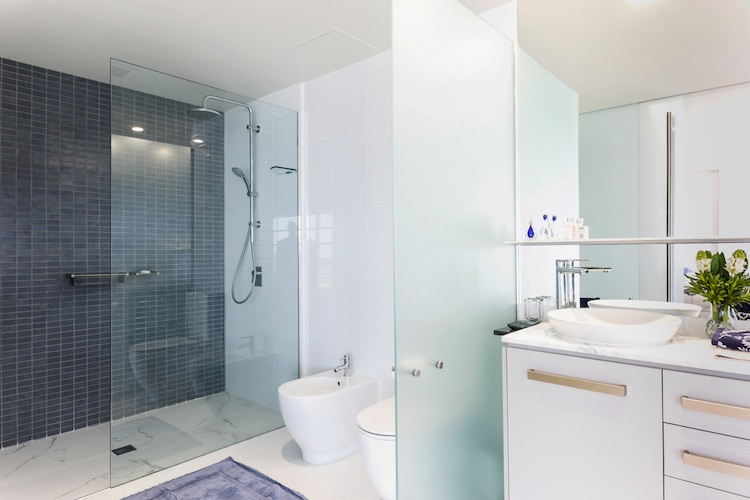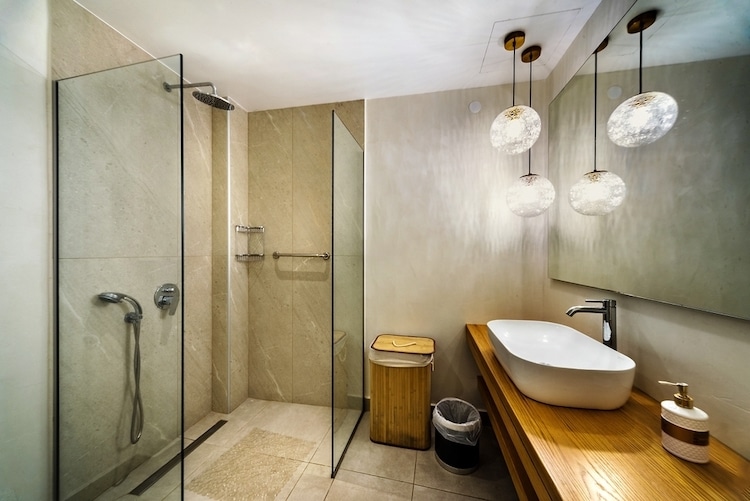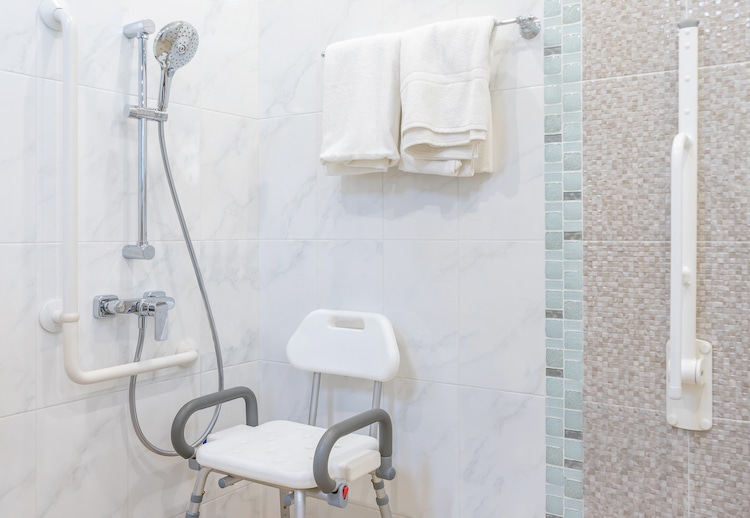Updated November 2025
Managing everyday life with a disability can be extremely challenging, and everyday tasks such as bathing for disabled adults often require thoughtful adaptations. Showering becomes particularly difficult without a properly designed disabled shower that supports safe, independent movement.
Whether you’re searching for mobility showers that reduce fall risk or replacing a standard bath with a fully accessible solution, this guide will help you understand the different types of disabled showers and how to transform your bathroom into a safe, comfortable and futureproof space.
Key Considerations When Choosing a Disabled Shower
When designing a disability bathroom, consider the following factors:
- Bathroom Space: Assess the size of your current bathroom and the space available for a new shower.
- Physical Abilities: Consider how long the user can stand, whether they can lift their legs over a bath, and how far they can reach comfortably.
- Type of Disability: Identify any additional features or equipment needed based on the specific mobility or health condition.
- Disruption Level: Over-the-bath showers are less disruptive to install than walk-in showers or wet rooms, but longer-term needs may justify the initial inconvenience.
- Cost: Over-the-bath showers are often the most affordable option, while wet rooms tend to be more expensive. Walk-in showers fall in the mid-range.
- Style: Functionality and aesthetics both matter. Choose a design that enhances comfort and confidence.
- Household Use: If others share the bathroom, select a shower that accommodates everyone’s needs.
No matter which option you choose—over-the-bath shower, walk-in shower, or wet room—it’s vital to consider how your needs may evolve in the future.
A well-designed disability bathroom allows for safety, independence, and dignity in everyday routines.
At Age Care Bathrooms, we are dedicated to enhancing the safety and comfort of showering for individuals with disabilities, limited mobility, and wheelchair users. With many options and features available, selecting the ideal accessible walk-in shower can be daunting. Let’s take a closer look at the various types and features of disabled showers and how they can support your specific requirements.
Why Choose a Disabled Shower Instead Of A Standard Shower?
Upgrading to a disabled shower provides far more safety and confidence than a standard cubicle. These mobility showers are specifically designed to reduce slips, remove tripping hazards and support independent movement. Features such as anti-slip flooring, level-access trays, supportive seating and easy-reach controls make daily bathing for disabled adults significantly easier and safer.
If you have any additional queries, don’t hesitate to call our friendly team of bathroom experts for advice or book your free home survey and no-obligation quote.

5 Types of Accessible Showers for Disabled People
Walk-in showers for elderly and disabled individuals can be adapted to suit a wide range of mobility needs and existing bathroom setups. Here are five popular types of showers used in disability bathrooms:
Types of accessible showers: Quick search
- Low-Level accessible showers
- Walk-in baths with showers
- Level access showers and wet rooms
- Accessible showers with cubicles
- Thermostatic mixer showers.
1. Low-Level Accessible Showers
These showers feature trays no more than 40mm high, making them easier to step into and reducing the risk of tripping. Ideal for people who don’t need a wheelchair but benefit from safer entry and exit. They’re compact and quick to install, even in smaller bathrooms.
Compared to traditional shower enclosures, disabled showers offer enhanced usability for people with limited mobility. Standard showers often include raised lips, narrow doors or slippery trays, while mobility showers are built to allow comfortable entry, stable seating and safe washing without strain.
2. Walk-In Baths with Showers
Walk-in baths combine bathing and showering for those who want both options. Overhead showers can be added to easy-access walk-in baths. For users with severe disabilities, rising ergonomic seats can assist with safe transfers. Shower controls are positioned within reach, making these baths ideal for wheelchair users and those with limited upper body strength.
3. Level Access Showers and Wet Rooms
These showers have no raised tray and sit flush with the floor—ideal for wheelchairs and reducing fall risk. Wet rooms maximise space in smaller bathrooms and remove barriers that may limit movement. They also allow carers more room to assist users if needed.
4. Accessible Showers with Cubicles
Cubicles offer more privacy while remaining accessible. Corner cubicles are ideal for saving space, while three-sided enclosures provide flexibility in placement. They can be combined with grab rails, fold-down seats, and other safety features for a fully tailored solution.
Related Reading: The Different Types of Shower Enclosures
5. Thermostatic Mixer Showers
These regulate water temperature automatically to prevent scalding. They’re perfect for multi-user households. RNIB-approved models feature raised markings and sound cues for the visually impaired. Electric showers are another safe option for consistent temperatures even when household water usage changes.
Related Reading: What Are Digital Showers?

Enhancing shower safety for mobility challenges: Quick search
- Mobility aids for accessible showers
- Seating for accessible showers
- Showering and seating safety tips
- Choosing the perfect shower temperature.
Mobility aids for accessible showers
If getting around your shower is becoming difficult, it’s time to make a change. To improve your shower and bathing experience, we provide a range of mobility aids and safety features. Below are some of the most popular mobility aids that, when used with accessible showers, can help keep you or someone you care for safe and comfortable when showering.
- Shower head holders: Adjustable shower head holders allow the shower head to be positioned at a height that suits the user.
- Shower screens and enclosures: For additional privacy, a shower screen or enclosure can be portable or fixed. They come in various configurations and are ideal for wet rooms and walk-in showers.
- Long-handled bathing aids: There is a wide selection of long-handled bathing aids with handles of different lengths, such as sponges and bath brushes. For a person with limited mobility, they can make washing easier and reduce the need to stretch or twist, which may cause discomfort and increase the risk of a fall.
- Leg lifters: Moving your legs when seated on a chair or swivel chair over the bath’s rim can be easier with leg lifters. You use a reinforced strap with a loop at one end and then physically lift your leg into the bath.
- Anti-slip mats and flooring: In every bathroom, anti-slip mats or anti-slip flooring can help prevent slips and falls. We have many different anti-slip flooring options and supply a range of anti-slip mats.
- Grab bars: Provide extra support around the bathroom. These are often placed on walls around the shower or bath area and come in two types:
- Horizontal rails: Great for both walk-in showers and baths. They can help you push up from a sitting position and also provide additional support when sitting down.
- Vertical rails: They can be placed around the bathroom for extra support. Having them next to a shower seat can be very helpful and will stop you from slipping.
- Transfer boards: Also known as a sliding board or transfer slide, these are designed to help disabled people move safely and easily from a wheelchair to a bath or shower seat. They are particularly useful for those with limited mobility or strength, enabling them to transfer independently or with minimal assistance.
- Shower boards: These are designed to fit over the top of your bath and act as a seat so you can sit down and shower in your bath. They are suitable for most styles of baths without fixed shower screens.
- Swivel bath seats: If you require extra support, swivel bath seats fit over the bath and swivel inwards. They are great for back support and also act as an armrest. These seats are set in a fixed position and do not lower into the bath.
Related Reading: Elderly Bathing and Hygiene Guide
At Age Care Bathrooms, our, friendly team of bathroom experts can help you pick additional mobility aids, features and fittings that suit your needs. This may be adding a shower seat, installing anti-slip flooring in the rest of your bathroom or swapping your toilet for a low-level disabled toilet.
Please get in touch with our caring team of mobility bathroom experts to arrange a free home survey and no-obligation quote.
Seating for accessible showers
Sitting down in walk-in showers can change showering from a difficult experience to an enjoyable one in comfort and independence. Various seating options are available in showers for disabled users, and the best shower seat will depend on your individual needs.
Below are five main shower seating options to consider:
1. Shower stools: These are available in various sizes and styles, including corner shower stools. Folding shower stools are also available, which take up less space if you want to put them away when not in use.
2. Wall-mounted shower seats: These are classified into two types: static and hinged. Certain models will have back support and armrests, but you should check with the manufacturer to see if there are any weight restrictions.
3. Shower chairs: You can choose from static or mobile shower chairs in all shapes and sizes. All shower seats will come with rubber cups on the legs to prevent any slipping and may be more suitable for a person who can’t use a wall-mounted shower seat due to weight restrictions. For extra comfort, most shower chairs come with armrests and padded seating.
4. Shower chairs on wheels: They are perfect if you want to move the chair around and have the security of knowing it will not move once you have put it where you want to sit in the shower. These tend to have metal frames and plastic seats and are generally smaller than a standard shower chair.
5. Self-propelled shower chairs: Available in many styles and designs, these are typically multi-functional. A popular choice is a self-propelled commode chair, which can be folded when not in use. For independence and dignity, they are designed so the user can propel themselves into the shower. Self-propelled shower chairs can also be pushed by someone else and will travel across carpet, tiles and lino.
You should always check to see if your shower tray or bath is capable of having a seat on it with the added weight of a person. Why not book a free home survey and no-obligation quote? We can help you find the shower and seating most suited to your needs and preferences.

Showering and seating safety tips
Improving shower safety for those with mobility issues involves several key considerations. Here are some things that can help make showering safer for people who are elderly or have disabilities.
- Ensure that the shower seat is stable and does not wobble; a fixed folding shower seat is an excellent option if other people in the household prefer to stand in the shower.
- Keep showering products, such as soap, razors and shampoo, in a holder on the wall close to the shower controls for easy access.
- Take your time getting on and off the shower seat, and use grab bars and anti-slip mats to help prevent slips and falls.
- Distribute weight evenly and avoid sitting on the edge of the shower seat or chair.
Related Reading: 10 Essential Bathroom Aids for the Elderly and Disabled
Choosing the perfect shower temperature
According to the Chartered Institute of Plumbing and Heating Engineering, shower temperatures should not exceed 41°C. Temperatures above this can cause dizziness or low blood pressure.
Use thermostatic gauges to ensure a safe and consistent temperature every time you shower.Advice and Support from Age Care Bathrooms.
Making bathroom modifications for a disabled person doesn’t have to be a stressful process. At Age Care Bathrooms, you don’t have to sacrifice design for functionality. Our team of bathroom specialists is dedicated to helping you choose the best accessible shower or mobility bathroom to meet your needs and budget.
We offer a wide range of disabled showers designed for the elderly, disabled people and wheelchair users, ensuring that showering is a comfortable, dignified and independent experience. Our stylish and practical solutions allow you to enjoy your bathroom without compromise. Whether you need a walk-in shower, a mobility wet room or a customised solution, Age Care Bathrooms has the expertise and options to make your bathroom safe and accessible.
At Age Care Bathrooms, we have been installing disabled showers for over 30 years. To schedule your free home survey and discover more about our mobility bathroom adaptations, call us today at 0800 999 8994 or complete our online enquiry form.
If you’re considering a new disabled shower or want advice on mobility showers tailored to your needs, our experts are here to help. Book your free home survey today and explore safe, stylish options for bathing for disabled adults.
Download our free brochure or speak directly with a friendly specialist – we’re here to help.
Frequently Asked Questions About Disabled Showers
What is a disabled shower?
A disabled shower is an accessible bathing area designed to support people with limited mobility or disabilities. It usually includes level access, grab rails, seating and thermostatic temperature control.
Are disabled showers suitable for small bathrooms?
Yes. Low-level trays and compact mobility showers allow full accessibility even in smaller rooms, and wet rooms maximise the available space.
How much does a disabled shower cost?
Costs vary depending on layout, features and mobility needs. A free home survey provides an accurate quote based on your current bathroom and personal requirements.
What is the safest type of shower for disabled people?
Level access showers and wet rooms offer the safest entry and exit, especially for wheelchair users or anyone with a high risk of falls.
